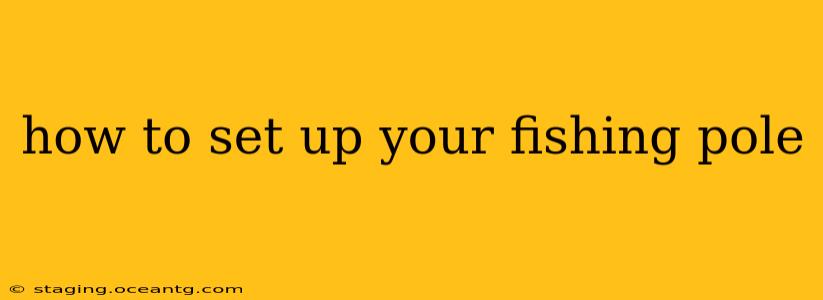Fishing can be a relaxing and rewarding hobby, but before you can cast your line and reel in a catch, you need to know how to properly set up your fishing pole. This guide covers everything from assembling the rod to attaching the reel and line, ensuring you're ready for a successful fishing trip.
What You'll Need
Before we begin, let's gather the necessary components:
- Fishing Rod: Choose a rod appropriate for your fishing style and the type of fish you're targeting.
- Fishing Reel: Select a reel compatible with your rod and fishing technique (spinning, baitcasting, or spincast).
- Fishing Line: The line's strength and type (monofilament, braided, fluorocarbon) depend on the fish you're targeting.
- Fishing Hooks: Select hooks appropriate for your bait or lure and the size of the fish you expect to catch.
- Bobbers (Floats): Optional, but helpful for surface fishing.
- Swivels: Connect your line to your leader and prevent line twist.
- Weights (Sinkers): Help cast your line and keep your bait at the desired depth.
- Bait or Lures: Choose bait or lures appropriate for the fish you're targeting.
Assembling Your Fishing Rod
Most fishing rods come in multiple pieces. Here's how to assemble them:
- Identify the sections: Examine your rod and identify the butt section (the longest piece) and the tip section(s).
- Align the sections: Carefully align the ferrule (the connecting piece) of one section with the corresponding ferrule of the next section.
- Insert and twist: Gently insert one section into the other, twisting slightly until they are firmly connected. Repeat this process until all sections are joined.
Attaching the Reel to Your Rod
The method for attaching your reel depends on the type of reel and rod you have. Most rods have reel seats designed for specific reel types.
- Locate the reel seat: This is the part of the rod designed to hold the reel.
- Position the reel: Place the reel onto the reel seat, ensuring it's securely seated.
- Tighten the reel nut or screws: Tighten the reel nut or screws to secure the reel to the rod. Make sure it's firmly attached but not overly tight.
Spooling Your Reel with Fishing Line
This is a crucial step, as improper spooling can affect your casting distance and overall fishing experience.
- Thread the line: Thread the fishing line through the guides (the small rings along the rod) and into the reel's spool.
- Fill the spool: Carefully fill the spool with fishing line, leaving a small amount of space at the top (about 1/8 inch). Avoid overfilling, as this can cause problems with casting.
- Tie a knot: Secure the end of the fishing line to the spool by tying a reliable knot (such as an Arbor Knot).
Attaching Your Hook, Bait, and Other Accessories
The process of adding your hook, sinker, and bobber depends on your fishing method and chosen bait or lure. However, the general steps include:
- Tie a knot: Secure your line to the hook, swivel, and other accessories using appropriate knots.
- Attach your bait or lure: Attach your bait or lure to the hook.
- Adjust your weights and bobber: Adjust your weights and bobber to the appropriate depth for your fishing technique.
How to Choose the Right Fishing Line for Your Needs?
The choice of fishing line significantly impacts your fishing experience. Consider these factors:
- Type: Monofilament is common for its flexibility and affordability; braided line is stronger and more sensitive; fluorocarbon is less visible underwater.
- Test Strength: Select a line strong enough to handle the type and size of fish you are targeting.
- Diameter: A thinner line is less visible to fish but may break more easily.
What Kind of Knots Should I Know How to Tie?
Knowing several reliable knots is essential for fishing. Learning these will improve your success and minimize frustrating line breaks:
- Improved Clinch Knot: Excellent for connecting line to hooks and lures.
- Palomar Knot: Strong and easy to tie, suitable for various applications.
- Arbor Knot: Specifically for attaching line to a fishing reel spool.
What Are the Most Common Mistakes When Setting Up a Fishing Pole?
Many common mistakes can hinder your fishing experience. Avoid these pitfalls:
- Overfilling the reel spool: This can lead to tangles and poor casting.
- Using the wrong type of line: Choose a line appropriate for the fish you are targeting.
- Tying weak or improper knots: Learn and practice several reliable knots.
- Not securing the reel properly: Ensure the reel is firmly attached to the rod.
By following these steps and tips, you'll be well-equipped to set up your fishing pole and enjoy a successful fishing adventure! Remember to always practice responsible fishing and respect the environment.
